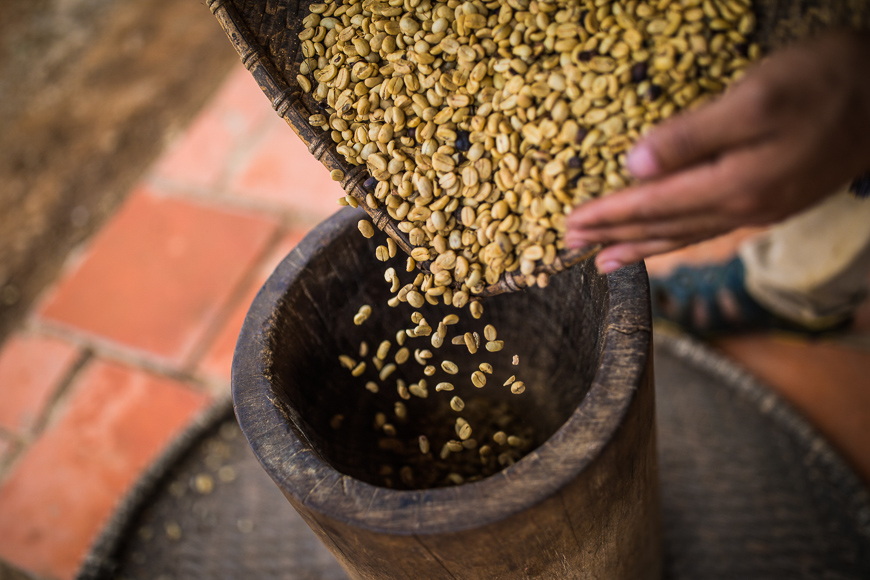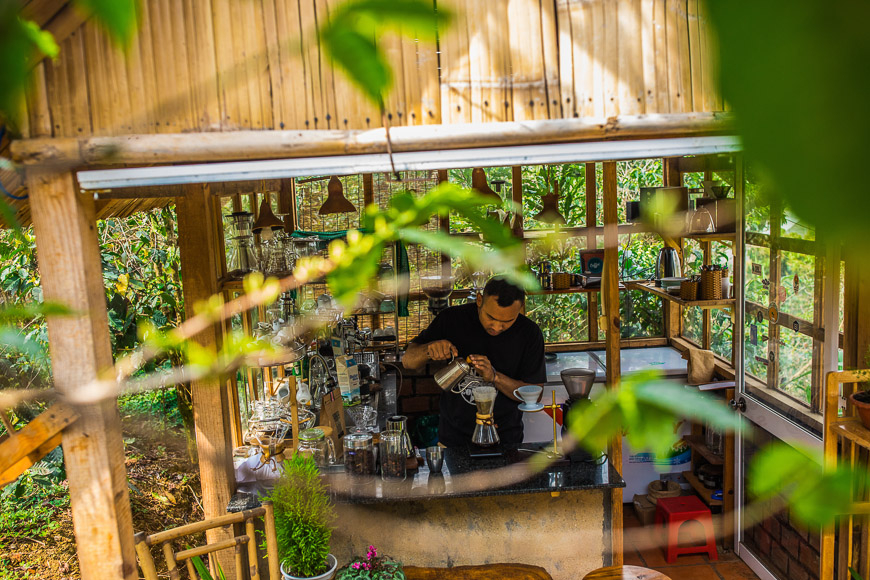The K’Ho Coffee Farm and Roastery, welcome visitors while proving that outstanding Vietnam coffee is an everyday thing. The farm owes its success to an enterprising family, and a trove of heirloom Arabica cultivated from seeds brought to Đà Lạt a century ago. The farm’s half-day workshops — which follow traditional methods of processing from tree to cup — are easily among the best coffee experiences in the country. Prepare to do a little work, drink a lot of coffee, and learn something entirely new.
Nestled on the slopes of Langbiang Mountain, the garden cafe at K’Ho Coffee Farm is surrounded by rustling coffee trees. Deep in the soil, the roots share a history stretching back to the late 1800s when the French were the first to bring Arabica seeds to Vietnam from Africa. In 1912, the colonizers founded a resort town for themselves in Da Lat City, 10 kilometres away, and enlisted the ethnic K’Ho minority in the area to tend their coffee trees.
 The K’Ho (or Ko Ho) is a nomadic minority, one of Vietnam’s 54 ethnic groups. They often built their hamlets in remote highland regions and lived off the land. By the early 1900s, the K’Ho had essentially become Vietnam’s first coffee farmers. Many years later, fourth-generation coffee farmer, Rolan Co Lieng found a way to grow it into a sustainable business, growing, roasting, and selling coffee descended directly from the Old World coffee seeds.
The K’Ho (or Ko Ho) is a nomadic minority, one of Vietnam’s 54 ethnic groups. They often built their hamlets in remote highland regions and lived off the land. By the early 1900s, the K’Ho had essentially become Vietnam’s first coffee farmers. Many years later, fourth-generation coffee farmer, Rolan Co Lieng found a way to grow it into a sustainable business, growing, roasting, and selling coffee descended directly from the Old World coffee seeds.
Arriving at the K’ho farm in Bonneur’C Village, you’ll notice how rustic it feels. Coffee seeds dry on screens outside the gift shop. Inside, the shelves are strewn with ethnic textiles, colourful crafts, and bags of richly scented beans. A wooden hut in the garden serves espresso and pour-over coffee with a view of Langbiang’s mountain farms.
After a quick introduction to the farm, take a walk between the coffee trees to see the berries up close, learn about the varieties of Arabica, and see agroforestry in action on K’Ho farms. Later, the guide will show you each stage in the process of coffee-making, employing the same methods the K’Ho have used for years.
K’Ho Coffee uses three types of processes: washed, natural, and honey. The coffee is selected and harvested by hand, wet-milled on-site, and after fermentation is left to dry for up to 20 days.
When the time comes, hulling is done manually using a wooden mortar and pestle and the chaff separated by winnowing. Your biggest challenge may be sorting the seeds, which requires a sharp eye and a careful hand. Only the best, unblemished seeds will make it to the gratifying steps of roasting, grinding and cupping.
 Throughout the workshop, the K’Ho guide offers small insights — a bite of a berry, an explanation of a term — that expand the appreciation of the work. The tour culminates in some very rewarding moments of brewing and tasting. Carry your cup to the garden cafe to savour your coffee in Dalat’s springtime sun. The fact that your coffee is sustainably grown, cleanly processed, and supporting local farmers is an enriching thought. Another thought: It’s delicious. You’ll probably want to grab a few bags before you go.
Throughout the workshop, the K’Ho guide offers small insights — a bite of a berry, an explanation of a term — that expand the appreciation of the work. The tour culminates in some very rewarding moments of brewing and tasting. Carry your cup to the garden cafe to savour your coffee in Dalat’s springtime sun. The fact that your coffee is sustainably grown, cleanly processed, and supporting local farmers is an enriching thought. Another thought: It’s delicious. You’ll probably want to grab a few bags before you go.
A half-day coffee tour at the K’Ho village farm costs 700,000 VND per person, including lunch. The gift shop and garden cafe are open from 8am to 4pm, Monday to Saturday. To book tours or for more information, visit www.khocoffee.com.
Photos and Article extracted from A Tour for Coffee Lovers via Visit Viet Nam


